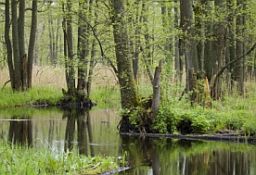|
Trees and Shrubs for Your Rain GardensTrees in a Rain Garden? Why not?
Trees and shrubs can help stop the erosion or degredation of low areas or slopes in your land. The thick woody roots of larger plant like trees and shrubs help to bind loose soil and hold it together, keeping it from sliding or washing away and leaving you with a constantly eroding spot on you property. Besides trees are among the Earth's great healers and provide birds with a great place to build a nest. Trees are an Integral Part of Wetland Many trees and shrubs grow naturally, right in the swamps. Think of the vast Cypress Swamps of Florida A Cypress is a large beautiful tree. I know that here on my property the Red Maples grow right down at the edge of our ponds and are constantly inundated by the rainy seasons. These trees are often accompanied by their bushy smaller cousins, as well as by the dozens of wildflowers, grasses, sedges and ferns mentioned on the rest of this site. Trees and shrubs complete the habitat. Trees, as you know are homes to a host of animals, from birds to mammals, to amphibians, like toads and frogs to reptiles like small lizards. They can also host beneficial insects like butterflies, ladybugs and bees. Fruit and nut trees and bushes can be a secondary food source for a lot of the native wildlife all year long. Trees and shrubs also provide nesting material in the form of twigs, seed fluff, bark and in other things they might collect, such as shed fur from other species, including the family dog. The perfect tree planted in or near your raingarden could bring you natural habitat much closer to nature than you could ever get without one, besides if you like ferns or some of the other plants that prefer part shade to full shade, trees and shrubs will bring that shade to you garden. \nHere are the tree and shrubs lists by region:
|






